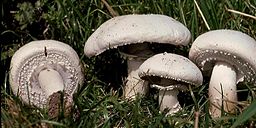 The Poisonous Cortinarius australiensis can look quite like an edible horse mushroom.
The Poisonous Cortinarius australiensis can look quite like an edible horse mushroom. Both are
- about the same size
- fleshy
- have hints of yellow
- have a ring
- have a pale cream cap which may have fine scales.
How to tell the difference

 Close up showing the ring of Cortinarius australiensis to be a cortina
Close up showing the ring of Cortinarius australiensis to be a cortina 
The gills of the poisonous look-alike are initially very pale mustard and darken to a distinct rust brown due to the typical rust coloured spores of Cortinarius mushrooms. The specimen in this photo shows both a section of newly exposed, pale mustard gills. Notice in this photo how much the still attached parts of the cortina looks like an agaricus ring rather than the usual fine threads a Cortinarius web. However, the gill colour identifies this mushroom as a Cortinarius.
Differences in the mature mushroom
The gills of the horse mushroom are chocolate brown even at this fairly early stage. Notice also how much longer the stem is in the horse mushroom.





 RSS Feed
RSS Feed




